QuestionQUESTION: Hi my name is Kyle and a recently got 2 German red bearded dragons the (Male) i think is about from head to tail is 13inch the (female) is about 8 or 9 inch i have 1 circle thermometer with the humidity gage its at about 10 20 percent. And another sticker thermometer at about 95 to a 100 degrees they are both in a 3 feet long 2 feet high 1 foot wide with the white sand the pet store said they needed they eat crickets and lettuce grapes i was wondering from a professional if what i am doing is correct i plan on building a big tank for them in about 2 weeks. I hope you can answer me back soon with everything i need to know it would be greatly appreciated thank you
ANSWER: Hi Kyle,
On the thermometers, they aren't the most accurate at all. The strip ones are actually way off on readings. The other problem with both kind is that you aren't actually measuring the temperature in the basking area at your beardies level, right where he lays. In the care sheet below there is more info on a good type of thermometer to use. For the other areas of the tank, the round stick on one will do in a pinch.
Your temperatures in the basking area need to go up a bit. You are aiming for a gradient temperature of 95-105, so you see you aren't that far off and it can simply be a case of the position of your thermometer that you are getting those readings.
Your cage is a nice size for right now and its great that you plan on building something larger in a few weeks, but given the cage size, you can wait a bit longer if needed.
Given your beardies sizes, they must be pretty young. You may find that in the near future, you will have to separate them so that your female does not be bred too early in her life. Neither sex should be bred til at least 2 years of age. Actually, its best and highly recommended that they are kept separate other than for a short period of time during breeding season if you plan to breed. If you don't plan to breed, do be warned that even if you don't want them to breed, they will if not separated and the female can lay close to 80 eggs in a breeding season. You can see how hard that would be on a beardie and how extremely hard on a too young a female.
As to your diet, lettuce isn't a good staple for their "salad" part of their diet. I am VERY happy to see that you are offering salad though!!! So few of owners even know that they do need greens in their diet.
Better choices for their "salad" are collard greens, turnip greens, dandelion greens, endive, escarole, butternut squash...and of course other foods. More on diet in the care sheet below.
I'm glad you have asked questions...it shows you want the very best for your beardies!!!
Also, something very important....Don't listen to pet stores!!! The sand they say your beardies need...it can kill them. It can cause internal blockages. If you wish to use sand, the safest to use is childrens play sand. I also recommend that instead of the whole floor being sand, you provide a "sandbox" for them and use newspaper or carpeting in the tank. That way they can dig in the sand when they want, but is much safer as it won't be getting into their salad and accidentally eating it when they eat insects. Regardless of which you choose, please do stay away from any of the so called calci sand or digestible sands and substrates.
I also included several links that you can read more on caring for beardies!!!
BASIC BEARDED DRAGON CARE:
HOUSING:
For an adult bearded Dragon, a 50 -55 gallon is the smallest recommended tank. For a baby, nothing less than a 30 gallon tank will work for a very short time, so its best to just start out with the adult sized tank....you can add rocks and branches for climbing, being sure to not stack rocks too high to prevent them toppling over. Branches need to be secure. They like to have a hide log or cave too!! All items brought from outside need to be cleaned well before placing them in the BD's tank. To clean them, there are a few methods: to wash in a bleach solution of 1/4 cup of bleach to 1 gallon of water. Let them soak for about an hour, rinse them in hot water several times and then let them dry in the sun until completely dry. If the items are small enough, they can be baked in an over at 200 degrees for about 2 hours, check often to be sure they are not starting to burn. The items can also be boiled(simmered) for 30 minutes or so and then allowed to dry completely before
placing in the tank. I also suggest washing any pet store items such as caves, rocks, branches, etc before placing in the tank as that if the store would happen to have mites they can also be on the items we purchase. Any of the above methods are acceptable for cleaning. CAUTION!!! On store bought branches...be VERY careful with the driftwood pieces that have the holes in them!!! Be sure the holes are small as that if the holes are large, the BD MAY be able to get his head in them but not able to get it back out!!! A secure screen top is necessary for bearded dragons as that also they do not require much height for climbing..they can and do climb!! NEVER USE HEAT ROCKS OR HEATED CAVES!!! They malfunction and cause severe burns and even death!!!!
SUBSTRATES:
Young bearded dragons MUST be kept on paper towels, newspaper or other non particulate(loose) substrate to prevent them from getting any loose substrate into their mouth and swallowing it which can and does cause intestinal blockages.Once the BD is over 10 inches, some people have had good luck using play sand mixed with 50% of peat moss. I prefer the safe substrate of the newspaper, or other non particulate substrate to prevent any problems and also for ease of cleaning.
LIGHTING:
Supplying uvb can be done in a few ways. By special lights that come in fluorescent tubes or special screw in bulbs (mercury vapor)that are designed to produce uvb and heat. The tubes do not produce heat. UVB is needed by the beardie to be able to absorb the calcium in the foods they eat. With out the uvb, they will develop metabolic bone disease. There are tubes that say ''full spectrum'' but they do not produce any uvb.
With the correct tubes, they must say that they produce BOTH uvb and uva. The uvb needs to be 5% or higher. Repti Sun 10.0 and the Repti Glo 8.0's are a great source for uvb. The old "favorites" are the repti sun 5.0 or the Iguana light..which are the same tube, just different package. These need to be positioned 6-8 inches over the beardie for the 5% and 8% and 8-10 inches for the 10% so that they get the uvb that is needed. The tubes need to be replaced every 6-9 months as that they stop producing UVB long before they stop producing light.Using a fixture that holds two uvb tubes of at least 3 feet in length will provide adequate uvb for your beardie. There has been new studies that have proven that compact uvb lights, both the spiral/coil type and the ones that look like long "U's" laying on their side and a few other brands are causing what basically amounts to snow blindness in reptiles. To read more on this, you can go to http://www.uvguide.co.uk/index.htm
The link will take you to my discussion group and to a post that tells how to tell the new compacts from the old ones. IF your beardie is using one of the new ones, then the light should not be the problem. http://pets.groups.yahoo.com/group/UVB_Meter_Owners/message/6721
On the mercury vapor , they also produce heat. They also produce the uvb and uva. The best on the market now are the Mega Rays.(http://www.reptileuv.com) The distance from these are greater than the uvb tubes and the directions must be followed that are listed for the light. When using the mercury vapor lights, you don't need to have one light for uvb and one for heat. The Mercury vapor lights provide both.
HEATING AND TEMPERATURES:
Bearded Dragons have specific temperature requirements. For heat when using the uvb producing fluorescent tubes, a regular household lightbulb will work for DAYTIME heat. The wattage needed will vary to each situation such as tank size, room temperatures, air flow. Their basking area temperature must be between 95F and 105F degrees to allow proper digestion of food. Your basking area must be where the uvb light is as well as the heat source. Be sure that the BD cannot get too close to the heat source as that they WILL get burned! The ambient temperature range in the mid 80's . Cool daytime range of normal room temperature of low to mid 70's. Nighttime temperatures in the low to mid 60's is fine. NEVER USE HEAT ROCKS!!!!!!!!!!!!!!!!!!!!! A good digital thermometer is a must. I like using the duel ones with the probe...cost about 15$ at Wal Mart. The probe can be placed in the basking area at the BD's level to monitor this temperature and the main unit can be placed in one of the ambient temperature areas. When reading them, the "out" reading is the probe area.
DIET:
Bearded Dragons eat and need both animal proteins and vegetable matter!!! As young dragons they eat a bit more of the insects. As they get older, as adults their diet is more of the vegetable matter. As young BDs, the diet is about 80% animal proteins and 20% vegetable matter. As they get older, the ratio changes. An adult will eat about 80%-90% vegetable matter and 10-20% animal proteins.
Animal protein sources are: Crickets, superworms, silkworms, roaches, hornworms, waxworms. Waxworms are considered candy to a BD so only feed on occasion in a small amount(2-3 worms). ALL insects must be properly gutloaded for at least 48 hours prior to feeding to the dragon. For crickets and superworms, this can be done with vegetables, plain cereals and commercial foods for the species. Silkworms and the other insects have their own diet needs. Its best to feed the crickets in a separate feeding tank such as a 10 or 20 gallon size tank or container with a well vented lid. This can make it easier for the dragon to catch the crickets and prevents any stray crickets in their "home" tank from deciding to nibble on the BD if he happens to not find them all. If you do feed in his home tank, be sure to place a 1/2 potato in the tank to help prevent the crickets from biting at the BD. ALL insects fed must be no larger than the space between their eyes to prevent choking. Be sure to dust the insects daily(for dragons up to 14-15 inches) (2x wkly there after)with a good calcium source such as Rep Cal calcium powder with no added Phosphorus. Young BD's up to 4 months of age will eat more crickets than anything. At this age they will usually consume anywhere from 10 to 30+ correctly sized crickets three times a day. Be sure to remove any uneaten crickets that are not consumed in a 15-25 minute time frame. For this reason, its easier to use a separate feeding tank for the bearded dragon. A 10 gallon tank(with a screen top) works well. Its best to offer their "salad" of greens/veggies before offering their morning insect feeding when they are hungry to prevent any problems with them preferring NOT to eat their salad. Their salad consists of Collard greens, mustard greens, turnip greens, dandelion greens...... this is the BASE of the green part of their vegetable diet. To this, for variety you can add arugula, escarole, endive,small amounts of bok choy or other Asian greens. For the vegetable part of the diet, green beans, butternut squash, acorn squash(other winter squashes are also acceptable) yams, sweet potato. For color, sweet peppers can also be added in a small amount. For baby BD's, using a food processor for the greens and veggies works well. As they get older, greens should never be larger than about an inch x an inch in size. Never feed lettuces as they have no nutritional value. The hard veggies should be either food processed or grated. Fruits can also be offered in small amounts. Good fruits are figs, papaya, melon, blueberries, strawberries, raspberries....and many other fruits... these need to be mashed or chopped. Watermelon is a good source of water for the dragon. Their salad can be dusted once or at the most, twice a month with a good vitamin supplement such as RepCal HerptiVit. This is by no means a complete list of foods the dragons can eat.You can also offer baby food chicken or
small bits of boiled chicken.
Be sure to provide a dish of FRESH drinking water at ALL times!!! Misting their salad will also help get much needed water into them. NEVER FEED any MICE or other mammals to your Dragon!!!
WATER:
As stated above, always provide a dish of drinking water and mist their salad. You can also bathe your dragon a few times a week. (many bathe them daily for "bathroom duties") Temperature of the water should be between 85 and 95 degrees. The depth should never be any deeper than to cover his back when laying FLAT!!! Never leave them unattended at bath time to prevent possible drowning. Many love to soak and swim for 15 minutes or more. Never bathe less than two hours before his basking lights go out. Doing so can cause him to become too chilled, risking the chance of a respiratory infection.
A vet check up is recommended and a fecal sample taken in to be tested for any internal parasites.... To find a qualified vet in your area you can go to
http://www.herpvetconnection.com
http://www.arav.org/ECOMARAV/timssnet/amm/tnt_mdsearch.cfm
http://www.anapsid.org/vets/
More in-depth care info can be found at:
http://www.bio..miami.edu/ktosney/file/BDcare.html
http://www.sundialreptile.com/care%20sheet--bearded%20dragon.htm
http://www.blackninjakitty.com/herps/dragons
Most bearded dragons will take long naps (generally,if they are over a yr) in the fall.. this is called Brumation. is a form of hibernation. You can read more about that at
http://www.exclusivedragons.com/Brumation.html be sure to read this link as it tells you what to look for in brumation vs illness.
http://www.bio.miami.edu/ktosney/file/BDbrumate.html
http://worldofbeardeddragons.blogspot.com/2006/11/bearded-dragon-brumation-bruma
---------- FOLLOW-UP ----------
QUESTION: hi this is Kyle again thank you for writing back until i'm able to get some good sand i cleaned all of it from the one side at made a big pile on the other so theres no sand near the food or water... It seems that my beardies love each other there always beside eachother and every so often one will get on top of the other but they both do that.. And I was just wondering why i absolutely have to split them up and if I do can they stay together till i get the other one built ..... Can you please answer me again on this question because they don't fight (yet# they seem fine ... The male #i think) is already shedding his skin... thank you so much..
AnswerHiya Kyle,
Good on the sand piles of sand!! That was good thinking!!
Since they are german giants, they are young yet(based on their size) so I think you have some time before breeding issues start. They should be fine for a few weeks or months.
The reason its important to separate them(not right at the minute) breeding issues....breeding too young can cause the male to end up with prolapsed hemipene which when it does not go back in, it will need amputated. When they are together all the time, the male has breeding on his mind(when of age) and food isn't important to him and it can cause health problems. They can sometimes be very aggressive in their breeding advances, causing injury to the female.
With the female, too early of breeding can cause them to retain eggs or become eggbound which requires emergency surgery. The male will constantly bother her, causing stress...
Its great that they are getting along so well.
I just want to mention that even if you have two females, they may get along very well for a bit of time but can attack each other at any time so do keep an eye out. In a way, it would be great if you did end up with two females and they continued to get along. Then there would be no problem housing them together. If it turns out you have two males, well...there is no way they can be housed together as they would fight til death.
Great to hear that your larger one has shed!!
You may want to try feeding the smaller one separate if you don't think that one is getting enough otherwise. Sounds like you are doing great!!

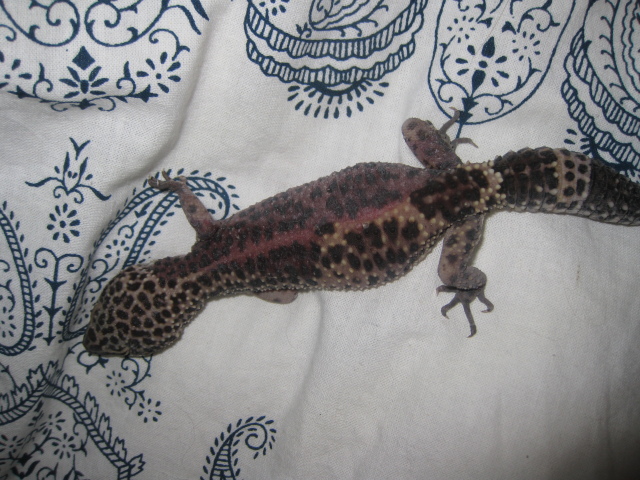 my leopard gecko is fading
QuestionSleeping stella
QUESTION: Hi, I have a v
my leopard gecko is fading
QuestionSleeping stella
QUESTION: Hi, I have a v
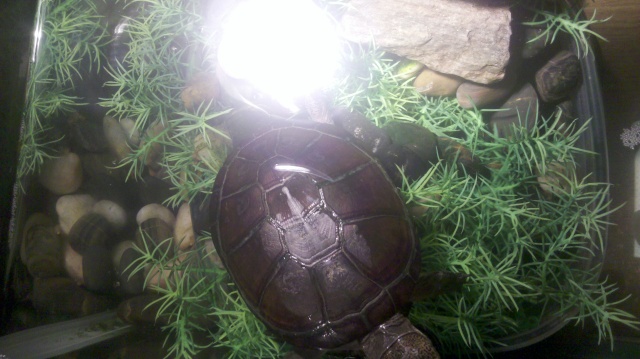 african sideneck turtle
Question
african sideneck
five had my African sidekick
african sideneck turtle
Question
african sideneck
five had my African sidekick
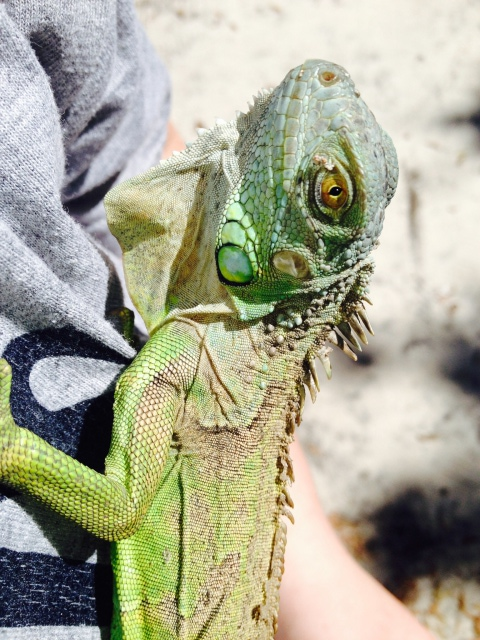 Green iguanas
Question
Green iggy
Hi I have two green iguanas
Green iguanas
Question
Green iggy
Hi I have two green iguanas
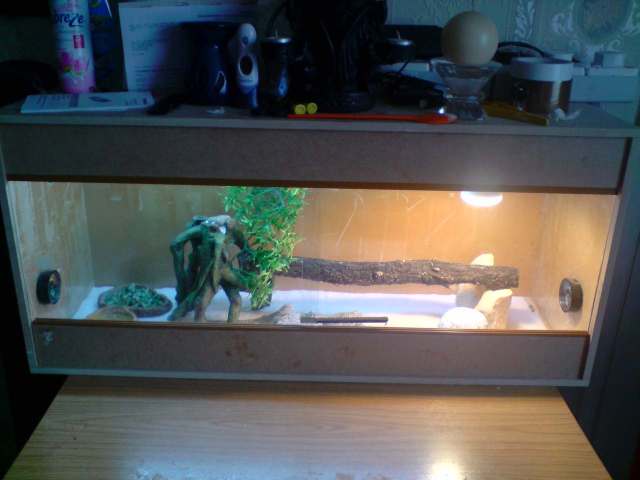 10wk beardie
QuestionQUESTION: hi diane,
here are the other links of
10wk beardie
QuestionQUESTION: hi diane,
here are the other links of
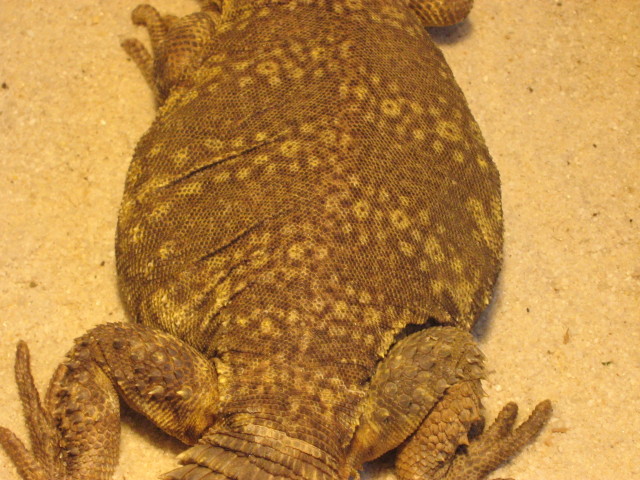 Gravid or fat?
Question
Gravid or just fat?
Hi again..i forgot to ment
Gravid or fat?
Question
Gravid or just fat?
Hi again..i forgot to ment